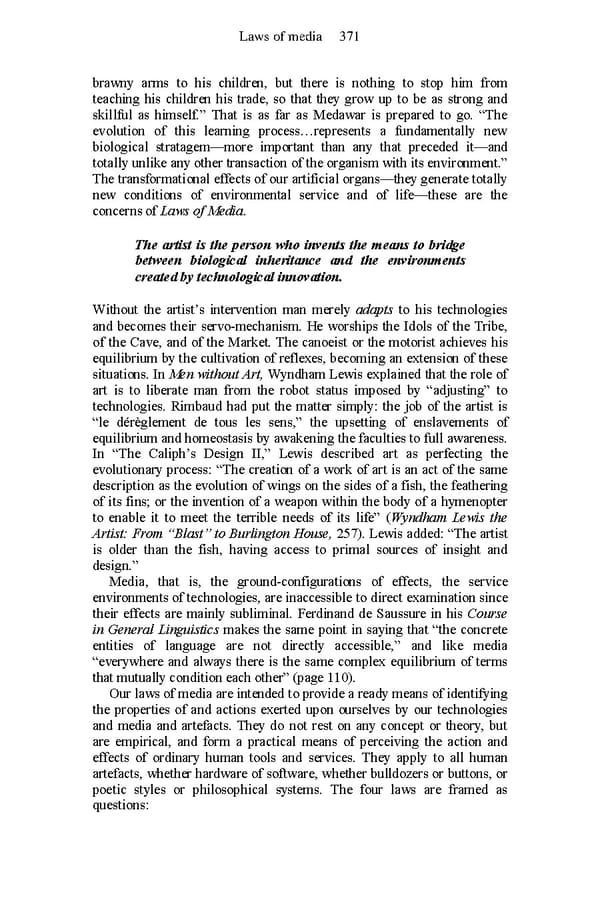Laws of media 371 brawny arms to his children, but there is nothing to stop him from teaching his children his trade, so that they grow up to be as strong and skillful as himself.” That is as far as Medawar is prepared to go. “The evolution of this learning process…represents a fundamentally new biological stratagem—more important than any that preceded it—and totally unlike any other transaction of the organism with its environment.” The transformational effects of our artificial organs—they generate totally new conditions of environmental service and of life—these are the concerns of Laws of Media. The artist is the person who invents the means to bridge between biological inheritance and the environments created by technological innovation. Without the artist’s intervention man merely adapts to his technologies and becomes their servo-mechanism. He worships the Idols of the Tribe, of the Cave, and of the Market. The canoeist or the motorist achieves his equilibrium by the cultivation of reflexes, becoming an extension of these situations. In Men without Art, Wyndham Lewis explained that the role of art is to liberate man from the robot status imposed by “adjusting” to technologies. Rimbaud had put the matter simply: the job of the artist is “le dérèglement de tous les sens,” the upsetting of enslavements of equilibrium and homeostasis by awakening the faculties to full awareness. In “The Caliph’s Design II,” Lewis described art as perfecting the evolutionary process: “The creation of a work of art is an act of the same description as the evolution of wings on the sides of a fish, the feathering of its fins; or the invention of a weapon within the body of a hymenopter to enable it to meet the terrible needs of its life” (Wyndham Lewis the Artist: From “Blast” to Burlington House, 257). Lewis added: “The artist is older than the fish, having access to primal sources of insight and design.” Media, that is, the ground-configurations of effects, the service environments of technologies, are inaccessible to direct examination since their effects are mainly subliminal. Ferdinand de Saussure in his Course in General Linguistics makes the same point in saying that “the concrete entities of language are not directly accessible,” and like media “everywhere and always there is the same complex equilibrium of terms that mutually condition each other” (page 110). Our laws of media are intended to provide a ready means of identifying the properties of and actions exerted upon ourselves by our technologies and media and artefacts. They do not rest on any concept or theory, but are empirical, and form a practical means of perceiving the action and effects of ordinary human tools and services. They apply to all human artefacts, whether hardware of software, whether bulldozers or buttons, or poetic styles or philosophical systems. The four laws are framed as questions:
 Essential McLuhan Page 377 Page 379
Essential McLuhan Page 377 Page 379